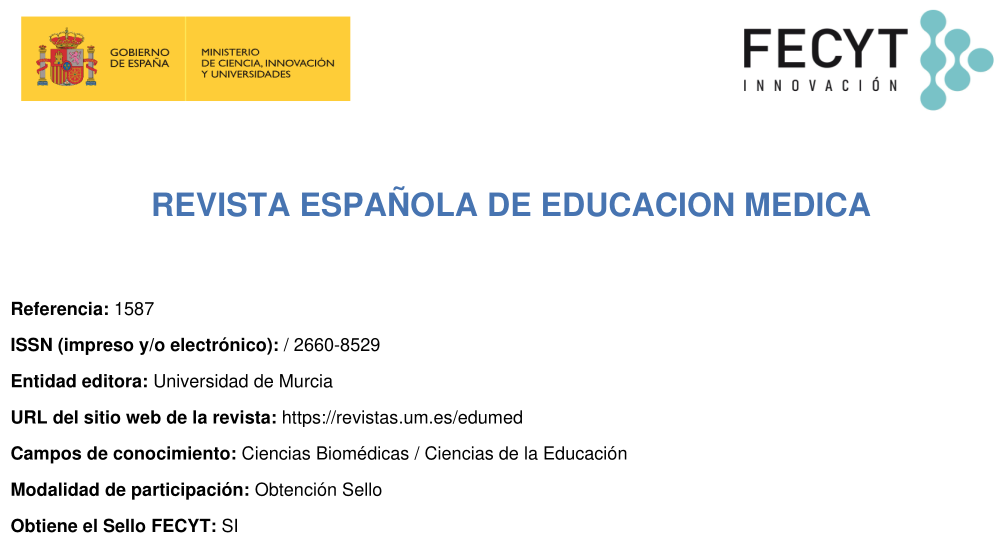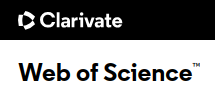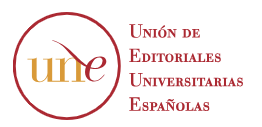El “residente como docente”: estudio fenomenográfico sobre las experiencias docentes en residentes de Medicina Familiar de una Universidad en Chía, Colombia
Abstract
medical residents represent a fundamental role in the training process of students, interns and peer-residents, with implicit teaching obligations as postgraduate students and without any type of training for it. Prior to the implementation of a “resident as teacher” program, it is useful to inquire about teaching experiences in context, in order to develop programs according to the characteristics and needs of the environment. This study sought to identify the variations in the teaching experiences in Family Medicine residents in a Colombian University. This is a qualitative research with a phenomenographic approach. Fifteen residents from different years of training responded a semi-structures interview. We identified 5 categories of description related in a hierarchical way by 7 dimensions of variation. The ways of experiencing the “resident as teacher” role are the imposed passive transmitter, the facilitator of knowledge, the facilitator of clinical practice, the role model and the “lifelong learner”. Variations in experiences of "resident as teacher" are determined by the interaction of personal and contextual factors. It is necessary to emphasize that the description categories are interconnected, with the potential to advance to the next category. The above can be used as a platform for the development of a "resident as teacher" program aimed to promote functional academic transformations towards the description categories with deeper understanding of the teacher role, a desirable situation in the Latin American context where residents have diverse teaching responsabilities.
Downloads
Metrics
-
Abstract527
-
pdf (Español (España))436
References
Ramani, S., Mann, K., Taylor, D., & Thampy, H. (2016). Residents as teachers: Near peer learning in clinical work settings: AMEE Guide No. 106. Medical teacher, 38(7), 642–655. https://doi.org/10.3109/0142159X.2016.1147540
Bayter, E., Cordoba, A., & Messier, J. (2017). Residentes como docentes en la Fundación Universitaria de Ciencias de la Salud (FUCS), proyecto de residentes formadores. Repertorio de Medicina y Cirugía, 26(1), 27–34. https://doi.org/10.1016/j.reper.2017.03.001
Hill, A. G., Yu, T. C., Barrow, M., & Hattie, J. (2009). A systematic review of resident-as-teacher programmes. Medical education, 43(12), 1129–1140. https://doi.org/10.1111/j.1365-2923.2009.03523.x
Ince-Cushman, D., Rudkin, T., & Rosenberg, E. (2015). Supervised near-peer clinical teaching in the ambulatory clinic: an exploratory study of family medicine residents' perspectives. Perspectives on medical education, 4(1), 8–13. https://doi.org/10.1007/s40037-015-0158-z
Zundel, S., Stocker, M., & Szavay, P. (2017). "Resident as teacher" in pediatric surgery: Innovation is overdue in Central Europe. Journal of pediatric surgery, 52(11), 1859–1865. https://doi.org/10.1016/j.jpedsurg.2017.05.029
Isenberg-Grzeda, E., Weiss, A., Blackmore, M. A., Shen, M. J., Abrams, M. S., & Woesner, M. E. (2016). A Survey of American and Canadian Psychiatry Residents on Their Training, Teaching Practices, and Attitudes Toward Teaching. Academic Psychiatry, 40(5), 812-815. https://doi.org/10.1007/s40596-016-0491-5
Mann, K. V., Sutton, E., & Frank, B. (2007). Twelve tips for preparing residents as teachers. Medical teacher, 29(4), 301–306. https://doi.org/10.1080/01421590701477431
Nawabi, S., Shaikh, S. S., Javed, M. Q., & Riaz, A. (2020). Faculty's Perception of Their Role as a Medical Teacher at Qassim University, Saudi Arabia. Cureus, 12(7), e9095. https://doi.org/10.7759/cureus.9095
Harden, R. M., & Crosby, J. (2000). AMEE guide no 20: The good teacher is more than a lecturer - The twelve roles of the teacher. Medical Teacher, 22(4), 334–347. https://doi.org/10.1080/014215900409429
Devine, L. A., Ginsburg, S., Stenfors, T., Cil, T. D., McDonald-Blumer, H., Walsh, C. M., & Stroud, L. (2019). Professional Responsibilities and Personal Impacts: Residents' Experiences as Participants in Education Research. Academic medicine : journal of the Association of American Medical Colleges, 94(1), 115–121. https://doi.org/10.1097/ACM.0000000000002411
Hubinette, M. M., Ajjawi, R., & Dharamsi, S. (2014). Family physician preceptors' conceptualizations of health advocacy: implications for medical education. Academic medicine : journal of the Association of American Medical Colleges, 89(11), 1502–1509. https://doi.org/10.1097/ACM.0000000000000479
Limberg, L. (2012). Phenomenography. In The SAGE Encyclopedia of Qualitative Research Methods (pp. 612–614). https://doi.org/https://dx.doi.org/10.4135/9781412963909
Larsson, J., & Holmstrom, I. (2007). Phenomenographic or phenomenological analysis: does it matter? Examples from a study on anaesthesiologists’ work. International Journal of Qualitative Studies on Health and Well-Being, 46(October 2006). https://doi.org/10.1080/17482620601068105
Röing, M., Holmström, I. K., & Larsson, J. (2018). A Metasynthesis of Phenomenographic Articles on Understandings of Work Among Healthcare Professionals. Qualitative health research, 28(2), 273–291. https://doi.org/10.1177/1049732317719433
Stenfors-Hayes, T., Hult, H., & Dahlgren, L. O. (2012). Three ways of understanding development as a teacher. European journal of dental education : official journal of the Association for Dental Education in Europe, 16(1), e151–e157. https://doi.org/10.1111/j.1600-0579.2011.00690.x
Stenfors-Hayes, T., Hult, H., & Dahlgren, M. A. (2013). A phenomenographic approach to research in medical education. Medical education, 47(3), 261–270. https://doi.org/10.1111/medu.12101
Emanuel E. ¿Que hace que la investigacion clinica sea etica? siete requisitos éticos. In: Investigación en sujetos humanos: experiencia internacional Santiago de Chile: Programa Regional de Bioética OPS/OMS [Internet]. 1999. p. 33–46. Available from: http://www.uss.cl/wp-content/uploads/2014/12/10.-REQUISITOS-ETICOS-EN-INVESTIGACIÓN.pdf%0Ahttps://www.bioeticacs.org/iceb/seleccion_temas/investigacionEnsayosClinicos/Emanuel_Siete_Requisitos_Eticos.pdf
Gerlese S. Åkerlind (2005) Variation and commonality in phenomenographic research methods, Higher Education Research & Development, 24:4, 321-334, http://dx.doi.org/10.1080/07294360.2011.642845
Jacobs, J. C. G., van Luijk, S. J., Galindo-Garre, F., Muijtjens, A. M. M., van der Vleuten, C. P. M., Croiset, G., & Scheele, F. (2014). Five teacher profiles in student-centred curricula based on their conceptions of learning and teaching. BMC Medical Education, 14(1), 220. https://doi.org/10.1186/1472-6920-14-220
Jacobs, J. C. G., van Luijk, S. J., Galindo-Garre, F., Muijtjens, A. M. M., van der Vleuten, C. P. M., Croiset, G., & Scheele, F. (2014). Five teacher profiles in student-centred curricula based on their conceptions of learning and teaching. BMC Medical Education, 14(1), 220. https://doi.org/10.1186/1472-6920-14-220
Hossein, K. M., Fatemeh, D., Fatemeh, O. S., Katri, V. J., & Tahereh, B. (2010). Teaching style in clinical nursing education: a qualitative study of Iranian nursing teachers' experiences. Nurse education in practice, 10(1), 8–12. https://doi.org/10.1016/j.nepr.2009.01.016
Cruess, S. R., Cruess, R. L., & Steinert, Y. (2008). Role modelling--making the most of a powerful teaching strategy. BMJ (Clinical research ed.), 336(7646), 718–721. https://doi.org/10.1136/bmj.39503.757847.BE
Coppell, R. (2020). Revisiting the Concept of the Anti-Role-Model for Social Learning Theory in UK Education. Research Ideas and Outcomes, 6. https://doi.org/10.3897/rio.6.e60683
Bandura, A. (1977). Social learning theory. Englewood Cliffs, N.J: Prentice Hall.
Laal, M. (2011). Lifelong learning: What does it mean? Procedia - Social and Behavioral Sciences, 28(May), 470–474. https://doi.org/10.1016/j.sbspro.2011.11.090
Kheong Lum, S., AS Burud, I., Shirahatti, R., & Barua, A. (2019). Students and Faculty Perspective of a Good Medical Teacher in the Asian Context. Journal of Surgery and Research, 2(3), 054–059. https://doi.org/10.26502/jsr.10020019
Stenfors-Hayes, T., Hult, H., & Dahlgren, L. O. (2011). What does it mean to be a good teacher and clinical supervisor in medical education?. Advances in health sciences education : theory and practice, 16(2), 197–210. https://doi.org/10.1007/s10459-010-9255-2
Imafuku, R., Saiki, T., Kawakami, C., & Suzuki, Y. (2015). How do students' perceptions of research and approaches to learning change in undergraduate research?. International journal of medical education, 6, 47–55. https://doi.org/10.5116/ijme.5523.2b9e
Sjöström, B., & Dahlgren, L. O. (2002). Applying phenomenography in nursing research. Journal of advanced nursing, 40(3), 339–345. https://doi.org/10.1046/j.1365-2648.2002.02375.x
Copyright (c) 2021 Servicio de Publicaciones de la Universidad de Murcia

This work is licensed under a Creative Commons Attribution-NonCommercial-NoDerivatives 4.0 International License.
The works published in this magazine are subject to the following terms:
1. The Publications Service of the University of Murcia (the publisher) preserves the economic rights (copyright) of the published works and favors and allows them to be reused under the use license indicated in point 2.
2. The works are published under a Creative Commons Attribution-NonCommercial-NoDerivative 4.0 license.
3. Self-archiving conditions. Authors are allowed and encouraged to disseminate electronically the pre-print versions (version before being evaluated and sent to the journal) and / or post-print (version evaluated and accepted for publication) of their works before publication , since it favors its circulation and earlier diffusion and with it a possible increase in its citation and reach among the academic community.


















